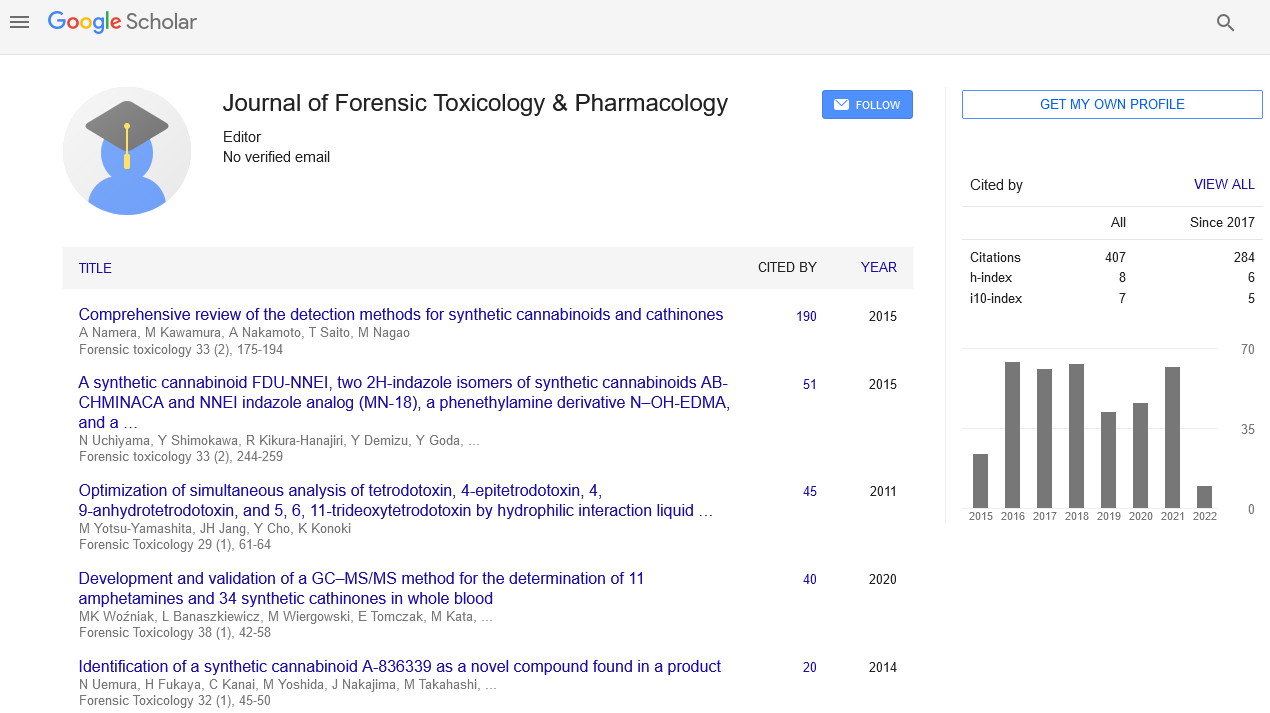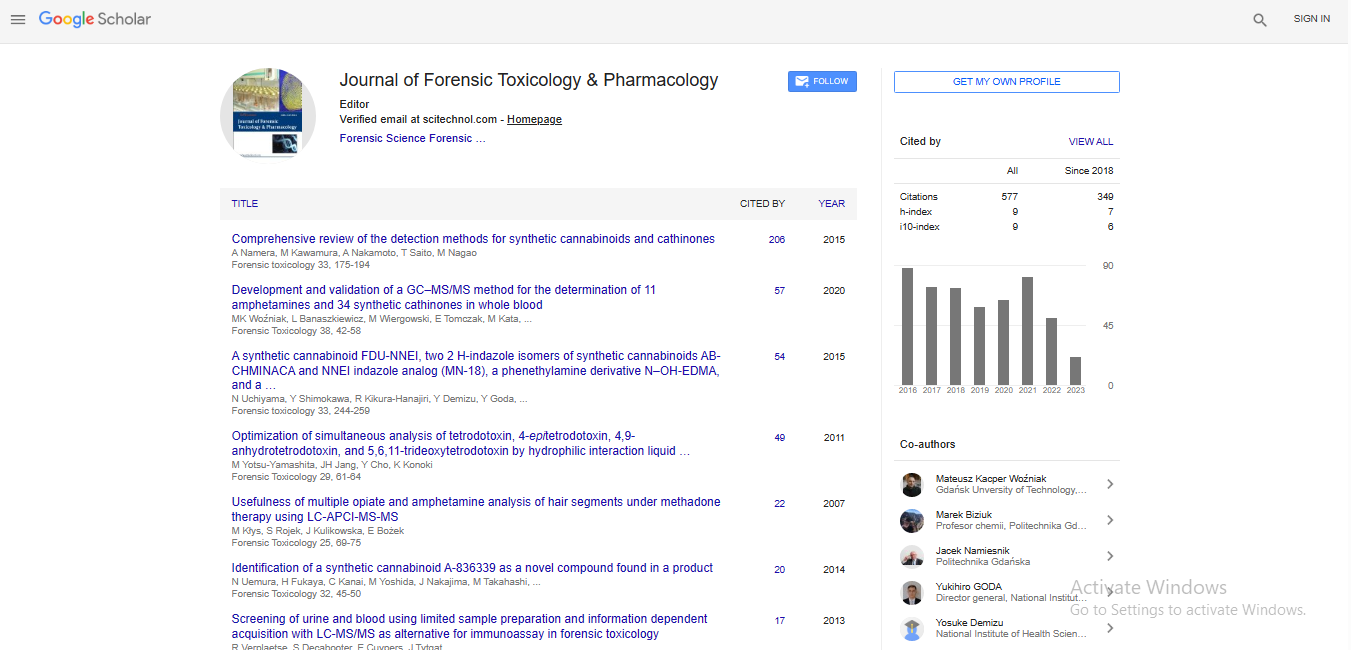Perspective, J Forensic Toxicol Pharmacol Vol: 13 Issue: 3
Artificial Intelligence in Predictive Toxicology: Enhancing Drug Safety Assessments through Machine Learning
Marie Louise Jensen*
1Department of Clinical Pharmacology, University of Copenhagen, Copenhagen, Denmark
*Corresponding Author: Marie Louise Jensen,
Department of Clinical
Pharmacology, University of Copenhagen, Copenhagen, Denmark
E-mail: jensenlouise@gmail.com
Received date: 26 August, 2024, Manuscript No. JFTP-24-151882;
Editor assigned date: 28 August, 2024, PreQC No. JFTP-24-151882 (PQ);
Reviewed date: 11 September, 2024, QC No JFTP-24-151882;
Revised date: 18 September, 2024, Manuscript No. JFTP-24-151882 (R);
Published date: 25 September, 2024, DOI: 10.4172/JFTP.1000194
Citation: Ogunka-Nnoka CU, Ben-Piakor TE, Mepba HD, Ifeanacho MO (2020) Effect of Processing on Phytochemicals and Nutrient Composition of Tiger Nut (Cyperus esculentus L). J Food Nutr Disor 9:2. doi: 10.37532/jfnd.2020.9(2).271
Description
The pharmaceutical industry faces continuous challenges in ensuring the safety of drugs before they are introduced to the market. Traditional toxicology studies, which often rely on animal testing and human trials, can be time-consuming, expensive and raise ethical concerns. To address these limitations, Artificial Intelligence (AI) is emerging as a powerful tool in predictive toxicology. By integrating Machine Learning (ML) techniques, AI can significantly improve the accuracy, efficiency and speed of drug safety assessments.
Machine learning, a subset of AI, involves algorithms that allow computers to learn from data and make predictions or decisions without being explicitly programmed. In toxicology, ML can analyze vast amounts of data to predict potential harmful effects of a drug on the human body, identify chemical properties that may pose risks and determine safe dosage levels. By using historical data from previous drug tests, clinical trials and post-marketing surveillance, AI models can learn to recognize patterns and correlations that human experts might miss.
One of the main challenges in drug development is identifying toxic compounds in the early stages of testing. ML algorithms can be trained on chemical and biological data to predict the likelihood of a compound causing toxicity. These predictions are based on the compound’s molecular structure, physicochemical properties and biological interactions. By analyzing data from previous experiments, AI can help researchers identify potential risks much earlier in the development process, reducing the need for extensive animal studies.
While in vitro (cell-based) and in vivo (animal) testing are essential for understanding a drug's effects, they have limitations in replicating the complexity of human biology. AI can complement these methods by providing insights that help researchers refine experimental designs and interpret results more accurately. Machine learning can analyze data from cell cultures, animal models and human clinical trials to identify patterns that might not be immediately obvious.
AI-powered simulations can predict how a drug will behave in the human body, estimating factors such as absorption, distribution, metabolism and excretion. This predictive power allows researchers to make better decisions about which drugs to advance to clinical trials, thereby reducing the risk of failure due to unforeseen toxicity.
The ethical concerns surrounding animal testing have led to a growing demand for alternative methods in drug safety assessments. AI in predictive toxicology offers a potential solution by reducing reliance on animal testing. By using data-driven approaches, ML algorithms can simulate how drugs interact with human cells, tissues, and organs, minimizing the need for animal models. This not only addresses ethical concerns but also accelerates the drug development process by providing more accurate predictions with fewer resources.
Several pharmaceutical companies and research institutions have already started integrating AI into their drug development processes. For instance, companies like In silico Medicine and Atomwise are using AI-driven platforms to screen compounds for toxicity and predict their safety profiles. These tools are becoming increasingly popular in the early stages of drug discovery, enabling faster decisionmaking and improving the overall success rate of drug development.
Artificial intelligence is transforming the field of predictive toxicology by providing powerful tools to enhance drug safety assessments. Through machine learning, researchers can predict toxicity risks early in the development process, refine experimental models and reduce the reliance on animal testing. As the technology progresses, AI will continue to play a vital role in improving the efficiency, accuracy and ethical standards of drug development. The integration of AI into predictive toxicology is not only making drug development faster and more effective but also making it safer for human use.
 Spanish
Spanish  Chinese
Chinese  Russian
Russian  German
German  French
French  Japanese
Japanese  Portuguese
Portuguese  Hindi
Hindi 
